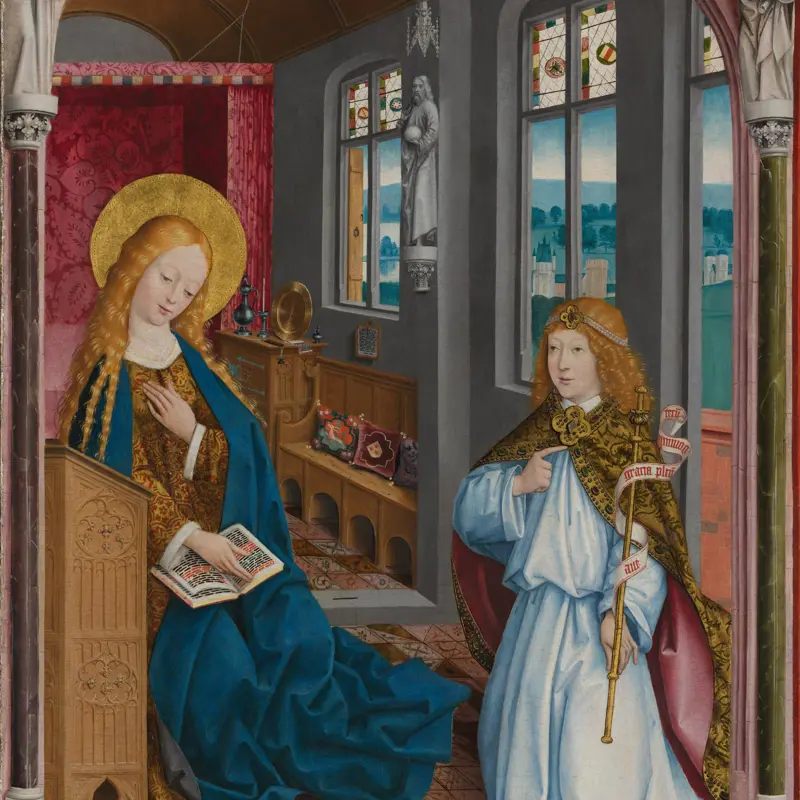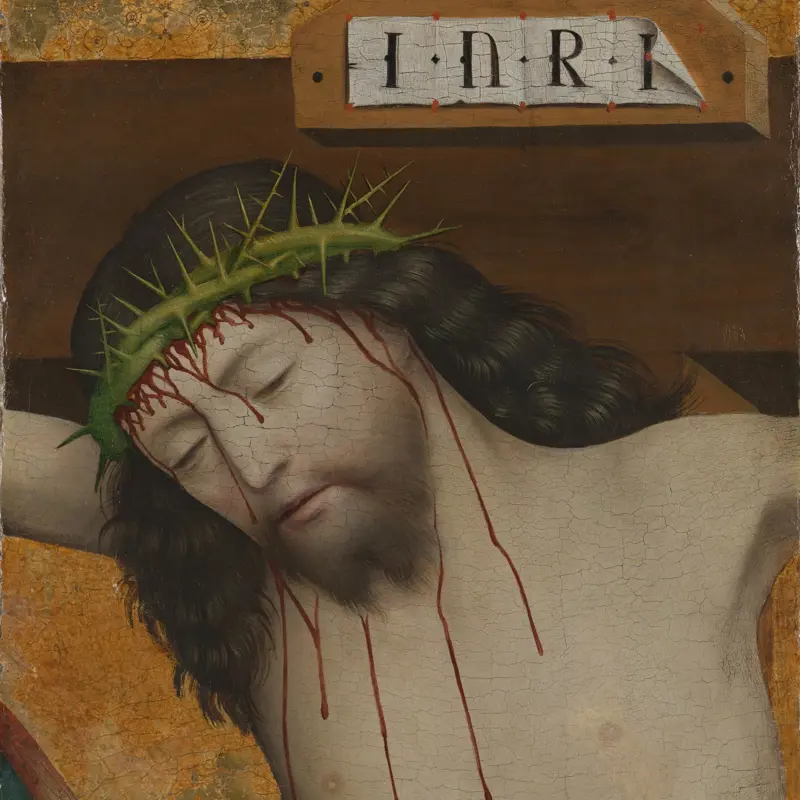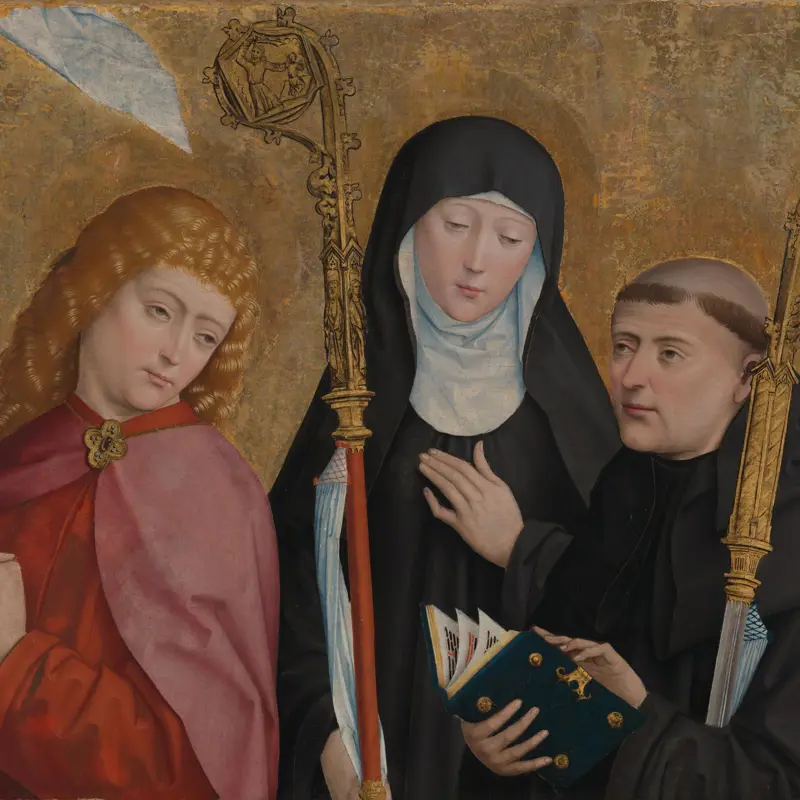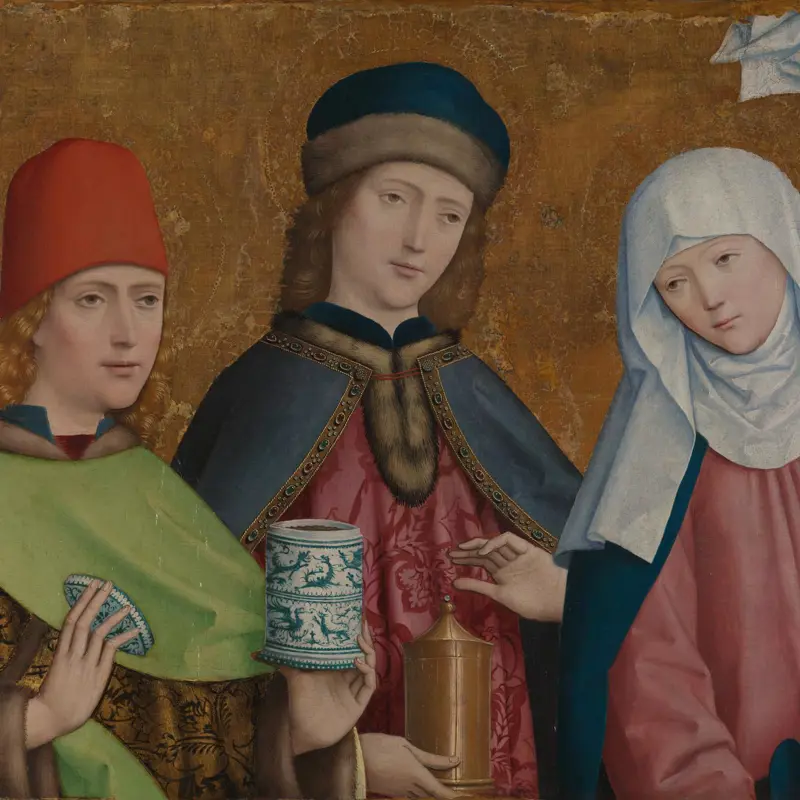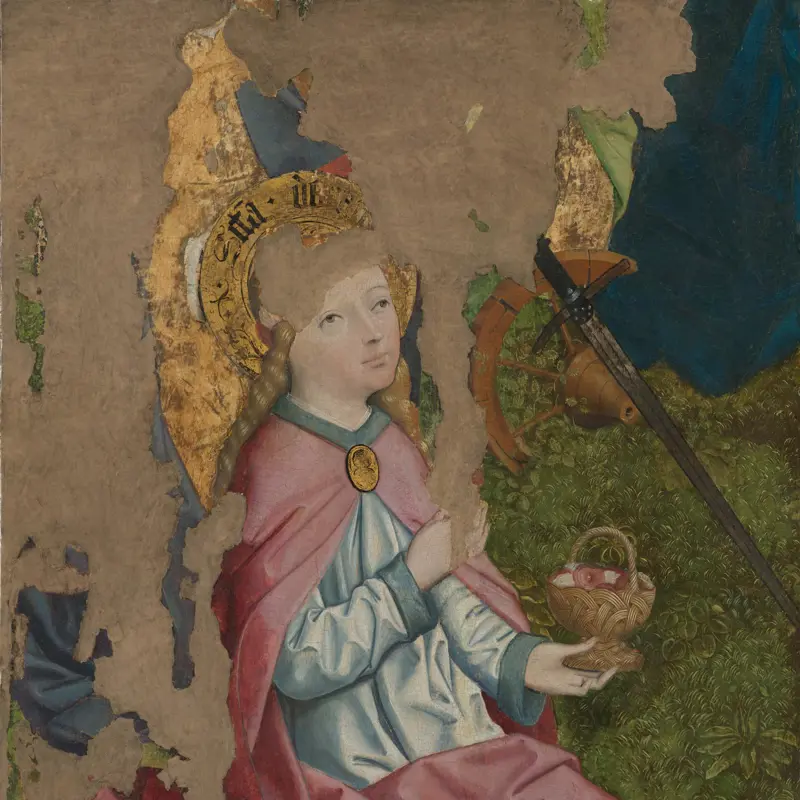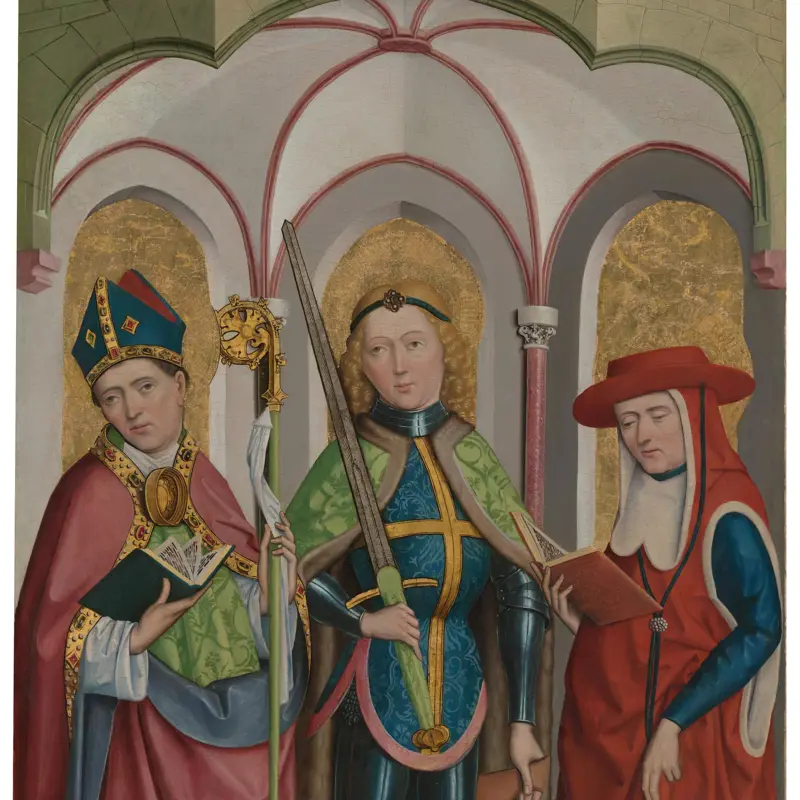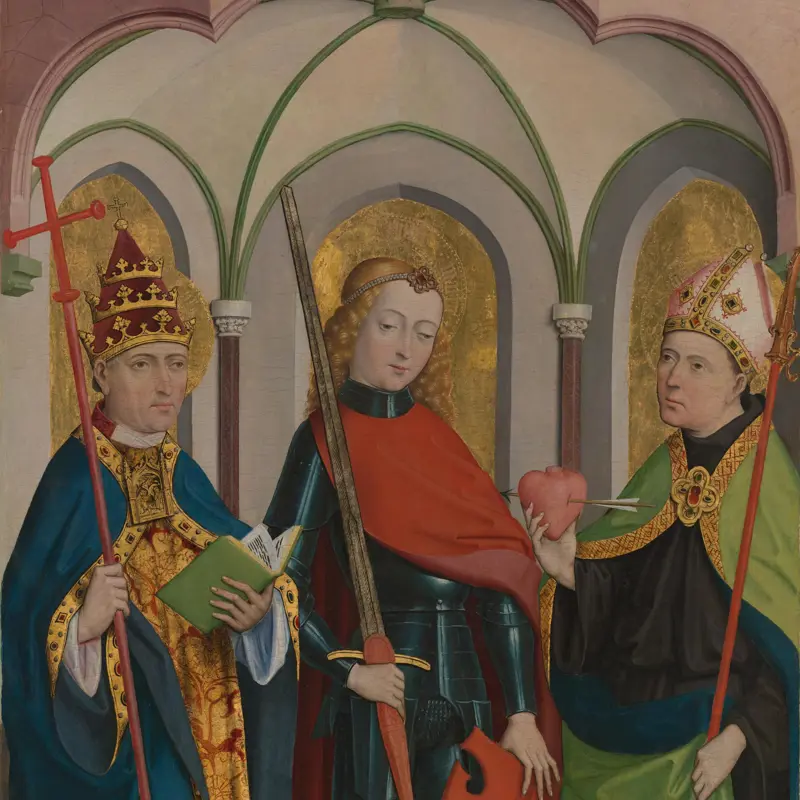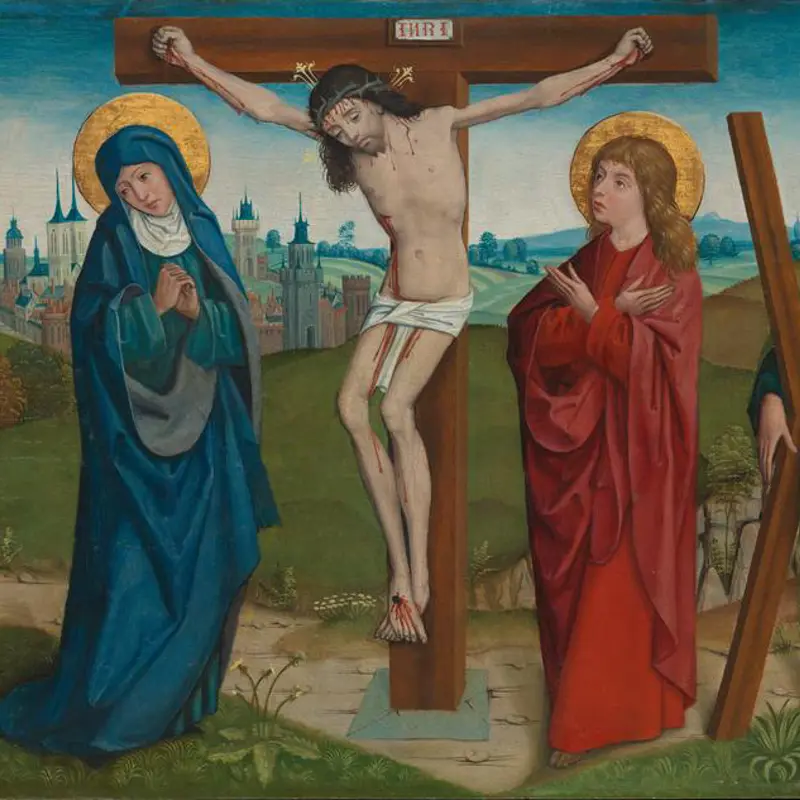Master of Liesborn (Johann von Soest?), 'The Presentation in the Temple', likely early 1480s-1490
About the work
Overview
This is one of the few surviving intact scenes which once formed part of an altarpiece made for the high altar of the Benedictine abbey at Liesborn in the west of Germany. This painting is likely to have originally appeared to the right of the main scene showing the Crucifixion.
Shortly after birth, Jewish boys were required by religious law to be presented at the temple to be consecrated. Here, the Virgin Mary is about to hand Christ over to the priest. This is Simeon, who is described in the Gospel of Luke as recognising Christ’s divinity and significance at this moment (Luke 2: 28–30). Simeon was one of the saints to whom the altarpiece was dedicated.
The artist has set this biblical event in a contemporary setting that would be familiar to worshippers. The temple, for example, is represented as a Gothic church with a high vaulted roof and decorative leaded windows.
Key facts
Details
- Full title
- The Presentation in the Temple
- Artist dates
- Active second half of the 15th century
- Part of the series
- The Liesborn Altarpiece
- Date made
- Likely early 1480s-1490
- Medium and support
- Oil, originally on wood (probably oak), transferred to canvas
- Dimensions
- 98.4 × 70.2 cm
- Acquisition credit
- Bought, 1854
- Inventory number
- NG257
- Location
- Not on display
- Collection
- Main Collection
Provenance
The high altarpiece of the abbey church at Liesborn near Münster was commissioned during the rule of Abbot Heinrich von Cleve (1464–90). The earliest reference to its existence is found in the history of Westphalia completed in about 1520 and written by Bernhard Witte (Wittius), a Benedictine monk from Liesborn who became a novice there in 1490. He records that Abbot Heinrich von Cleve had the high altar, which was dedicated to the Virgin, saints Cosmas and Damian and the prophet Simon, reconsecrated on 2 July 1465, the Feast of the Visitation, along with four other altars in the ‘lower church’ (ecclesia inferior); according to Witte, the abbot adorned the altars with altarpieces resplendent with gilding and colour by an unnamed ‘artifex’. The next reference to the Liesborn Altarpiece is apparently that made in the middle of the seventeenth century, when the altarpieces commissioned by Heinrich von Cleve were described by Abbot Georg Fuisting (ruled 1651–68) as ‘eleganti et admiranda pictura’, demonstrating that the high altarpiece was still valued at this date and that it had survived the occupation of the abbey during the Thirty Years War, concluded in 1648. However, in about 1704 the altarpiece was recorded as ‘miserrima’ (‘most miserable’). The refurbishment of the abbey had begun under the aegis of Abbot Gregor Waltmann (ruled 1698–1739) and by this date the original high altar had been removed to the west wall of the church to make way for a replacement in the baroque style, dated 1702 and incorporating an altarpiece of the Crucifixion by the Coesfeld painter Hermann Veltmann (1661–1723). A passage in a manuscript chronicle by the Benedictine priest and librarian Ferdinand Tyrell (1760–1830), who came to Liesborn in 1779, records that the original gilded and painted altarpiece was at that time displayed in the choir but had been spattered with paint during the whitewashing of the church in December 1788.
In 1803, following the Napoleonic occupation, Liesborn abbey was secularised. An inventory of 281 objects and works of art still in the Liesborn abbey church in November 1803 was prepared by the Prussian commissar charged with the suppression of local churches and other ecclesiastical foundations, but the Liesborn Altarpiece is not identifiable in it.
The art historian and tax inspector Carl Becker recorded in 1829 and 1833, possibly erroneously, that the Münster painter Johan Christoph Rincklake was charged with identifying works of value from the dissolved ecclesiastical foundations, but seemed not to have recognised the worth of the high altarpiece panels, perhaps because of their spattered condition. They were sold for 1 Thaler a piece to the local inhabitants, probably in 1807. It was said that one recipient, apparently finding some pieces to have been damaged in transport, allowed the panels to be cut up and some of the pieces lost or discarded. Clemens Wenzeslaus Freiherr von Oer (1768–1835), who owned the manor of Nottbeck in Stromberg, is said by Becker to have obtained these pieces, probably in about 1819. Perhaps as a result of his own financial difficulties, in 1826/7 he appears to have sold them to the lawyer and administrator Carl Wilhelm August Krüger; the latter arrived in Münster in 1826 and probably bought the Liesborn fragments at once, since it was noted in 1829 by Becker that Krüger had saved the fragments three years earlier. At the same time Becker gave a detailed description of the fragments in Krüger’s possession, in which all of the National Gallery pieces are mentioned. Krüger moved from Münster to Minden in May 1827, so had presumably acquired the pieces before that date. By 1829 Krüger had had them restored by the Cologne painter Maximilian Heinrich Fuchs (1767–1846). In 1833 the altarpiece was recorded in Carl Becker’s inventory of precious artworks in Westphalian ecclesiastical buildings, including those dispersed and recently destroyed, which was made in an attempt to record the rapidly vanishing Westphalian artistic heritage.
Johann David Passavant (1787–1861) saw the altarpiece fragments in Krüger’s collection at Aachen in 1833. Krüger had moved the collection to Minden by 1840. The catalogue of the Krüger collection published in 1848 identified the six works now in the National Gallery as ‘from the convent church at Liesborn’. They were purchased by the National Gallery with the majority of the Krüger collection in 1854, along with 14 other pictures said to be from the ‘Convent Church of Liesborn’ in the Krüger catalogue of 1848, which were sold off in 1857.
Additional information
Text extracted from the ‘Provenance’ section of the catalogue entry in Susan Foister, ‘National Gallery Catalogues: The German Paintings before 1800’, London 2024; for further information, see the full catalogue entry.
Exhibition history
-
2014Strange Beauty: Masters of the German RenaissanceThe National Gallery (London)19 February 2014 - 11 May 2014
Bibliography
-
1959Levey, Michael, National Gallery Catalogues: The German Schools, London 1959
-
2001
C. Baker and T. Henry, The National Gallery: Complete Illustrated Catalogue, London 2001
-
2024S. Foister, National Gallery Catalogues: The German Paintings before 1800, 2 vols, London 2024
About this record
If you know more about this work or have spotted an error, please contact us. Please note that exhibition histories are listed from 2009 onwards. Bibliographies may not be complete; more comprehensive information is available in the National Gallery Library.
Images
About the series: The Liesborn Altarpiece
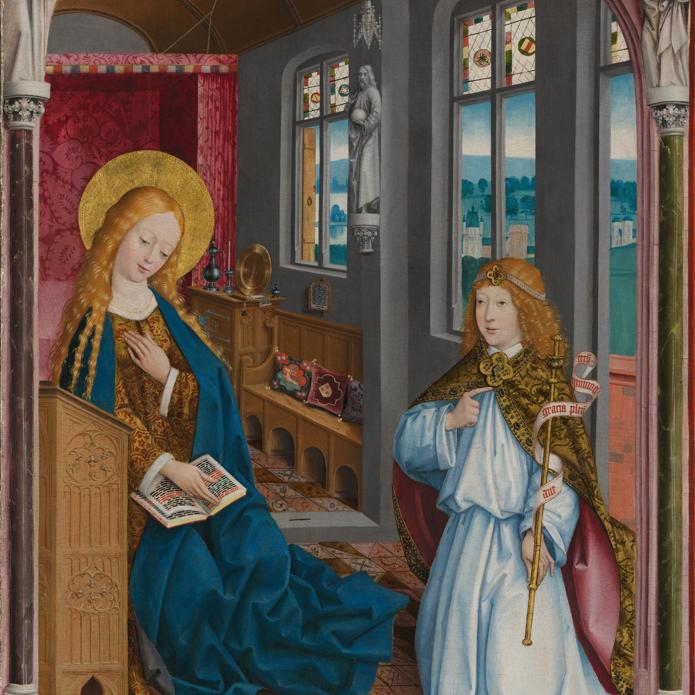
Overview
These images once formed part of a large altarpiece made for the high altar of the monastery church of the Benedictine abbey at Liesborn, in Westphalia in north-west Germany. The main panel consisted of a central scene of the Crucifixion, flanked on either side by two smaller individual scenes from Christ’s infancy.
In 1517 two shutters painted by the Master of Cappenberg were added to either side of the Master of Liesborn’s original panel. These showed the events leading up to Christ’s crucifixion, his resurrection and events that occurred afterwards, such as the Pentecost.
The altarpiece was removed in the eighteenth century and later cut up; only fragments survive. Six images from the main panel are in the National Gallery’s collection: three fragments of the central Crucifixion, two complete flanking images (The Annunciation and The Presentation in the Temple) and a fragment of The Adoration of the Kings, another flanking scene. Two further images come from the shutters.

